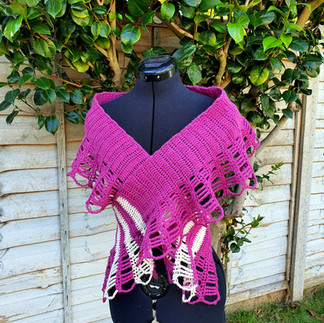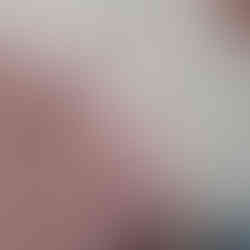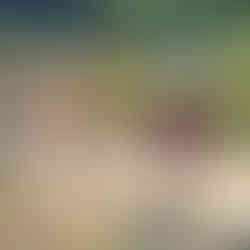How to Create Beautiful Knitting and Crochet Projects with your Scrap Yarn
- Joanne

- Apr 22, 2024
- 7 min read
Updated: Apr 29, 2025
Do you ever find yourself surrounded by leftover yarn scraps after completing a knitting or crocheting project? You're not alone! I think most crafters face the challenge of what to do with those leftover lengths and part balls of yarn that accumulate over time. Well, they hold immense potential for creativity and sustainability. In this blog post, we'll explore knitting and crocheting with leftover yarn scraps, turning what might seem like waste into beautiful and practical creations.
First Assess your Yarn Scraps
While it's easy, well easier, to remember the full sweater quantities of yarn we have and not usually too difficult to find a project for them, the leftovers we accumulate can fade into the background and never get used unless we make them prominent in our yarn collection, so let's start by looking at what we have and maybe sorting them into quantities so we know what we can achieve with them
Odd and half used balls of yarn
When we buy yarn for a project we can often have around half to a full ball leftover from our purchase and I think many yarncrafters are often prone to buying an odd skein of something that just takes our fancy but then sits in our stash because it isn't enough for the larger projects we love to create. I'm sure I'm not the only one! I like to store these hanging in 2 mesh bags (one for plant fibres and one for animal fibres) so that I can easily see them and remember what I have. Those bags are quite full now that I get yarn supplied for design commissions; maybe I should use some scraps to make a new bag!
Yarn scraps
By this I mean those pieces that are too small to still be in their original put-up and need winding up into a mini ball at the end of the project, usually more than a metre/yard up to about 20 metres/yards. It's easy to forget about them as they're so little and we probably feel like we finished that yarn anyway. I'm thinking I should separate these from the bigger balls as I don't really notice them. I've see crafters use a large glass jar to store them and they look so pretty.
Trimmings

These are, for example, the little leftovers we trim off when we complete a project that is designed to let you continue until you run out of yarn, but even there, you're probably not going to want to stop halfway through a row round or stitch pattern repeat; or maybe, like me you always overestimate what's needed for your long tail cast-on or leave extra long tails for seaming but didn't need all of them. Even these pieces can help add individuality and creativity to your finished makes. You may like to store your trimmings as a magic ball, like I do. Mine starts with the trimmings from my very first knitting project, a navy blue cotton short sleeved top. I am rather behind on adding my trimmings to it. Not sure what a magic ball is? Watch my friend, Nichola's video.
What shall we make with them? Knitting and Crochet Projects with your Scrap Yarn
Now that we can see what we have, we get to the fun part of picking projects for our yarns. Do you usually pick projects for yarns you own or do you tend have a project or pattern in mind first and then pick a yarn for it? I definitely do the latter more often but when I try to find a project for a yarn, I often find myself having lots of fun making something I wouldn't otherwise have picked.
Make small items
Click image to see how to get the pattern for any of the items shown
There are some great opportunities to make one-skein projects: wearable items like a neckerchief, fingerless mitts or ear-warmer; children's accessories too, such as little hats, scarves, booties can be worked up with a surprisingly small amount of yarn and for the home, the possibilities are endless: placemats, washcloths and scrubbies, plus all manner of cosies and containers.
Make larger items by combining scraps
Click image to see how to get the pattern for any of the items shown
Beautiful works of art can be created by combining different yarns into one larger piece. You don't even have to choose a pattern that was designed for lots of different yarns. Many patterns that can work in this way. I especially love switching yarns with granny square type projects where you work motifs in rounds. You just need to think about how the stitch will look with your colour changes and whether you like that kind of look for the finished piece. Your swatch can tell you a lot about how the stitch pattern will look when you use different yarns and you should also think about how the placement of colours overall will look in the finished item. A simple outline sketch shaded with where your colours will go can really help give an idea of the finished item.
You don't have to just add yarns one after another either. Consider adding multiple yarns of different shades together and knitting or crocheting with large needles or hooks as if they were one yarn. It looks like a fancy, chunky variegated yarn was used, especially if you change each yarns as it runs out rather than all at one time. My mum knitted my sons cosy garter stitch blankets for their infant car seats in just this way and I love the scarf that Tuula crochets in this video too, using the same idea.
Think also about whether you want to achieve a vibrant, scrappy look that you discover as you go by using yarns at random or plan out the different colours and textures before starting for a more considered arrangement or perhaps you might fall somewhere between the two. My scarf design for Simply Crochet falls into this last category. I chose the darkest shade for the edging and drew the colour order for the next motif at random but held aside the previous one worked so I didn't have two the same next to each other.
Make trims and use for other purposes
Click image to see how to get the pattern for any of the items shown
Finding ways to use the smallest scraps seems as if it could be a challenge but actually these are some of the most useful pieces.
You know how high quality clothing brands provide a little scrap of fabric, buttons and matching yarn/thread for repairs? Well you could keep an album of mending kits for all of your handmade treasures in exactly that way. A photo album with little pockets for the photos works really well for this. If I give a handmade item as a gift, I flatten one of the yarn bands with the care label for the most delicate yarn outermost and punch a hole in one end where there's no writing, then I wrap some of the yarn trimmings for each yarn colour used around it and stitch on a spare button/snap fastener/tassel/pom-pom or whatever else the person might lose. And guess what I use to tie that to the gift through the hole I punched? Yes another of my trimmings! Now the person receiving the gift has everything they need to keep the item you made in great condition.
And speaking of tassels and pom-poms, your leftover yarn can make all sorts of fun embellishments for your handmades; your shop bought clothes, bags and homewares; and even be used alone as festive decorations for celebrations or just a special corner of your home or garden. Flowers are my favourite embellishment to add but maybe you already teell that unless you're new to my blog! Remember you can often add them with a snap fastener, button, ties or a key fob type loop if you aren't sure you want the decoration there all the time.
Embroidery is a great way to add a touch of individuality to your makes and again, the smaller scraps of yarn are just perfect for this. Picture chain stitch curlicues, lazy daisy flowers with french knots at the centre or neat rows of herringbone stitch or couching. Knitting, of course, lends itself especially well to Swiss daring/duplicate stitch additions, which I love doing, especially as I don't really enjoy working with multiple yarns at once when knitting but sometimes want that kind of look.
The Vivid Collections
My Vivid Collections of crochet patterns were designed with odd balls of yarn and yarn scraps in mind. Here are a few examples of how I used up leftovers from other projects to make them.
The bauble is a tiny project and works well with lots of yarn ends in different shades or 1-10 metres/yards
In the swatch above, I used a magic ball as colour two in the project, striping with a single solid colour yarn as colour one. I think it gives an amazing stained glass window effect.
If you don't have two yarns that match in weight, that's fine too. My younger son wanted black and bright striped Vivid Mitts (like liquorice allsorts!) but I only had black, cream, tan and two dull blue shades in the right weight of warm yarn, so we used the black as colour 1 and combined light blue, orange and purple 4ply/fingering weight for colour 2 and the results were amazing. We both love them!
I didn't have enough blue in any shade to make the Bucket Bag so I picked three blue yarns where I had around 100m /110 yds leftover from other projects and arranged them dark to light and used them as colour 1, while the coral colour they were alternated with gave a sense of harmony as colour 2.
The collections are now available as e-books / bundles at a lower price than the individual patterns. You'll receive them as pdf downloads in English in both UK and US crochet terms with links to video clips for tricky steps.
Buy on Ravelry:
Buy on Etsy:

So, next time you're tempted to throw leftover yarn scraps away, think again! With a bit of creativity and ingenuity, your scraps can be transformed into truly remarkable projects. Whether you're knitting a cosy blanket, crocheting a colourful scarf, or experimenting with fun accessories, there's no limit to what you can create with your leftover yarn. Embrace the challenge, let your imagination run wild, and join us in the journey of making the most out of every last inch of yarn. Also do share your own ideas about using up scrap yarn in the comments.







































































Comments